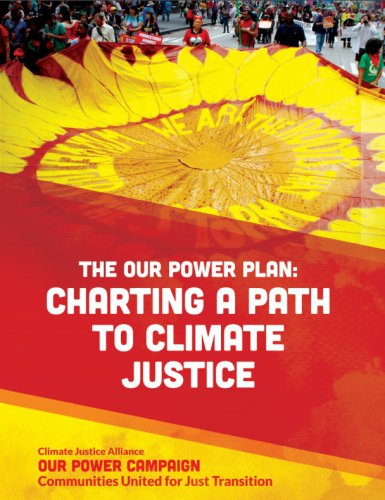On August 3, 2015 President Obama and the Environmental Protection Agency (EPA) announced the Clean Power Plan (CPP) to reduce power plant carbon emissions 32% by 2030 (from 2005 levels). The administration billed it as “an historic step in reducing carbon pollution from power plants that takes real action on climate change.” It is the first time the United States—historically the world’s largest emitter of the greenhouse gases that contribute to climate change—has committed to reducing carbon pollution from power plants, the source of more than 31% of our greenhouse gas emissions (GHGs).
The new policy is a fundamental part of the U.S. strategy to address climate change. At the same time, it will also have important health, economic, and environmental implications for frontline communities disproportionately affected by pollution and climate disruption. These are the Indigenous, African American, Latino, Asian, Pacific Islander, and poor white communities leading the Climate Justice Alliance.
And the Climate Justice Alliance has something to say to the state and regional leaders now preparing to implement the Clean Power Plan.
Download the Our Power Plan
The Our Power Plan
The CPP represents an important first step by the United States government in confronting climate change – but it does not go far enough. To begin with, the Clean Power Plan addresses only one part of the equation to address climate change – fossil fueled power plants. But even in that limited context, there’s room for great improvement.
This is why the Climate Justice Alliance (CJA) has issued a frontline Environmental Justice (EJ) community response to the CPP, called the Our Power Plan.
It identifies what in the Clean Power Plan is helpful and harmful for families and communities.
It presents clear and specific strategies for implementing the Clean Power Plan in a way that will truly benefit our families’ health and our country’s economy.
Our point of leverage as citizens now is the Federal and State Implementation Plans. States have until September 2016 to pull their plans together (2018 if extensions are approved). In this process,
- states are encouraged to conduct equity analyses;
- states must report to the EPA how they have conducted community engagement;
- a voluntary Clean Energy Incentive Program (CEIP) provides EPA matching funds for energy efficiency investments in low-income communities.
Table of Contents
| Introduction | |
| Background | |
| Who is CJA? | |
| Why this Report? | |
| Goals of the Our Power Plan | |
| Our Vision | |
| The Moment | |
| Our Plan | |
| A Just Transition From Extractive Energy To Strong Local, Living Economies | |
| Our Assessment | |
| The Clean Power Plan | |
| How the CPP Will Work | |
| Our Main Concerns | |
| Our Proposals | |
| How to Make The Clean Power Plan a More Effective Policy to Reduce Carbon Emissions and Achieve Environmental Justice | |
| Conclusion | |
| Appendix: CJA Membership | |
| Notes | |





